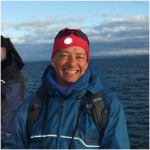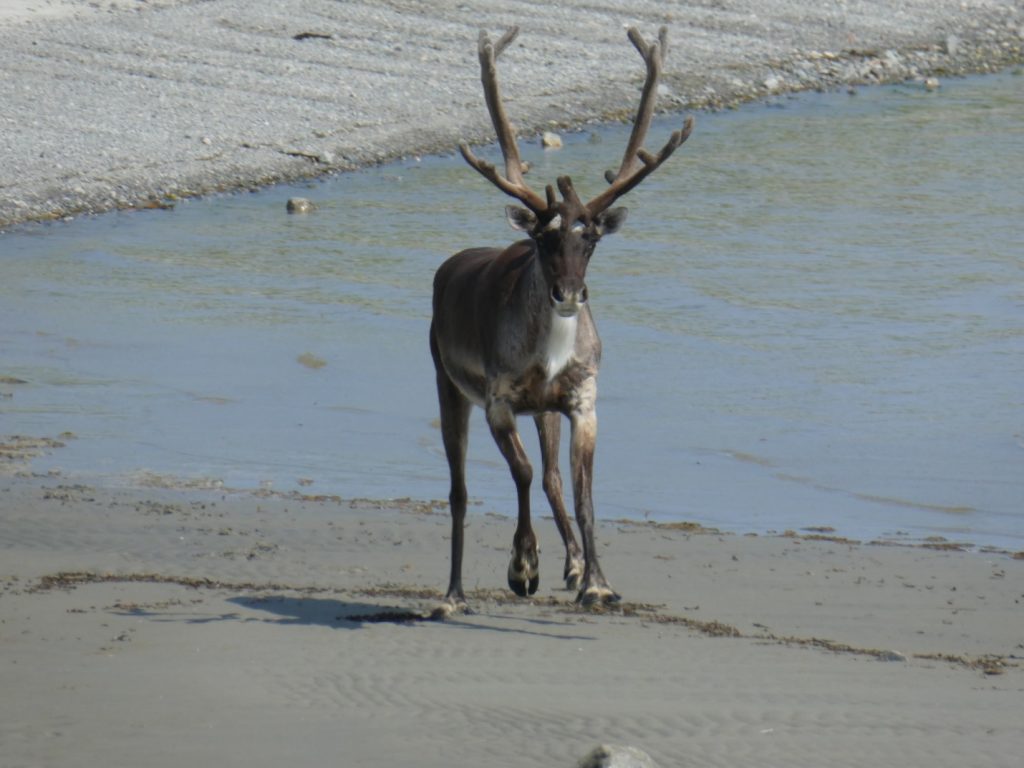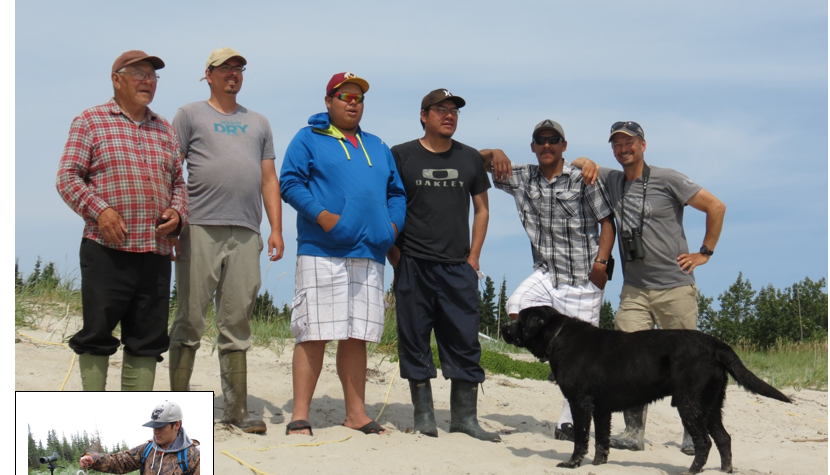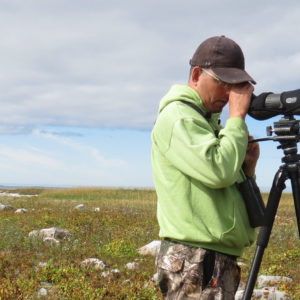Charlton Island shorebird expedition, 2016 – Part 2

Ted Cheskey
Senior Conservation Manager – Bird Conservation, Education & Networks
A joint project of Nature Canada, Environment Canada, the Cree Regional Government, the Waskaganish Cree Trappers’ Association and Eeyou Marine Region Wildlife Board
On July 30th, Garry Salt, local project coordinator, led the installation of MOTUS wildlife tracking antennae near the Jolly camp. Putting up the tower and installing the antennae and equipment took several hours of patience while Garry, Clayton and Jordan were harassed by an array of biting insects, particularly large flies (horse flies) that the locals call “Missak.” We have noticed that as the heat increases – it was over 20 today, the bugs come out. Mosquitoes swarms suddenly appeared around dusk, adding an irritation to those washing dishes outside! MOTUS antennas are designed to capture transmissions from tiny nanotags that are being attached to birds in many locations across Canada and the Americas. For more information about MOTUS, click here.

Garry Salt installing antennae to tower. Photo by Ted Cheskey
On July 31st the entire crew travelled together in two boats around the east side of Charlton Island on their way to the north side. We stopped at an Arctic Tern colony with about 200 adults nesting on a small gravelly island only a few hundred metres long, off the east side of the Charlton Island. We then continued to the drop off on a beautiful sand beach (good for landing boats) a few kilometres from the north-western tip of the island. Garry and Marc Antoine headed east along the beach, while Jordan and I walked west. Behind the large beach was an impressive dune system with an arid dune scrub forest that transitioned into the spruce forest on the island. After about a kilometre, the sand beach ended for Jordan and I. The remainder of the hike, which took about seven hours, was very hard on our feet – almost all on boulders, rocks and stones shattered by the severe winters, punctuated soft areas of unstable mudflats. To make things more challenging, the temperature had shot up above 30 degrees and the wind had died. There were relatively few shorebirds, but there were good numbers of Black and Surf Scoters off the coast – over 1000! We were hot and dehydrated when we reached the other camp around 9 pm. The other group explored the north shore, and after visiting a few areas realized that it was not good shorebird habitat for the most part, as the beaches were too sandy, clean and exposed to the north wind –though there wasn’t wind on that day.
The following day, August 1st, we hiked another 6 kilometres over the rocky shoreline to meet Clayton on the south-west tip of the island where we encountered a small group of Red Knots and found a nesting brood of Greater Scaup on a beaver pond. We met up with the other group who had been surveying an area on the southern side of the island.
The extreme heat continued on August 2nd. Clayton piloted one boat with Jeremy, Garry, Marc-Antoine and I to the Strutton Islands, about 25 kilometres to the north-east of the camp. Clayton dropped Jeremy and I on the south island, and took Garry and Marc-Antoine to the north island after visiting another tern colony. We observed a flock of 98 Red Knots, and a mix of other shorebirds. There were many signs of Caribou but no signs of Polar Bear to our relief. Marc-Antoine and Garry came face to face with a Caribou on the north island, (and Marc-Antoine again was quick with his camera!) as did Clayton on a small island between the main islands. We were surprised to observed caribou, and see so many signs of them, as there were no signs of caribou the previous year!

Woodland Caribou. Photo by Marc-Antoine Montpetit
On August 3rd, Marc-Antoine and I hiked from the camp to the west where we added the 100th species for Charlton Island on the expedition (a Great Blue Heron). In the afternoon, Bill drove Garry, Jeremy, Marc-Antoine and I to Danby Island for a return visit to see if the largest single flock of Red Knots was still at the same location 8 days earlier. To our surprise, it was. We counted 147 birds at the exact same place, making it the largest single flock yet. We had also observed coloured flags on several birds’ legs indicating that some individuals were originally banded in Canada, USA and Chile.
The expedition ended on August 4th, with a last short walk on the mudflats to the east of the camp before loading the boats and an 80 kilometre trip back to mainland Waskaganish. Over 9 full days, we observed 101 bird species, including many species at risk. These included 530 adult rufa Red Knots, plus Yellow Rail, Olive-sided Flycatcher, Short-eared Owl, Horned Grebe and Bank Swallow. Other notable birds were Black Guillemot, a large number of duck species including Common Eiders (adults and young), Wood Duck and approximately 5000 Black Scoter! The mammal list was also impressive with its own species at risk – Polar Bear, Woodland Caribou, Beluga (James Bay population), as well as Ringed Seal (not endangered). Remarkably the wind was generally calm allowing us to move around the islands by boat, and after a few cool days at the start, it became hot with light south winds that kept the tides low and weak. We arrived back at Waskaganish in late afternoon on the 4th, just giving us time to unpack and transfer equipment to the CTA office and my vehicle. A few hours later, a massive cold front slammed through Waskaganish with 100 plus kilometre per hour gusts, driving rain and intense lightning. The storm associated with the front lingered on through the night into the next day.

Figure 7: The Charlton Island Crew: Left to right, Host guide and boat pilot Bill Jolly, Marc-Antoine Montpetit, Jeremy Stevens, Garry Salt, Clayton Jolly, Ted Cheskey and Ringo. Inset: Jordan Rabbitskin
This expedition was undertaken with the financial support of Government of Canada’s Habitat Stewardship program (HSP), the Aboriginal Fund for Species At Risk (AFSAR), and support from the Eeyou Marine Region (EMR).



